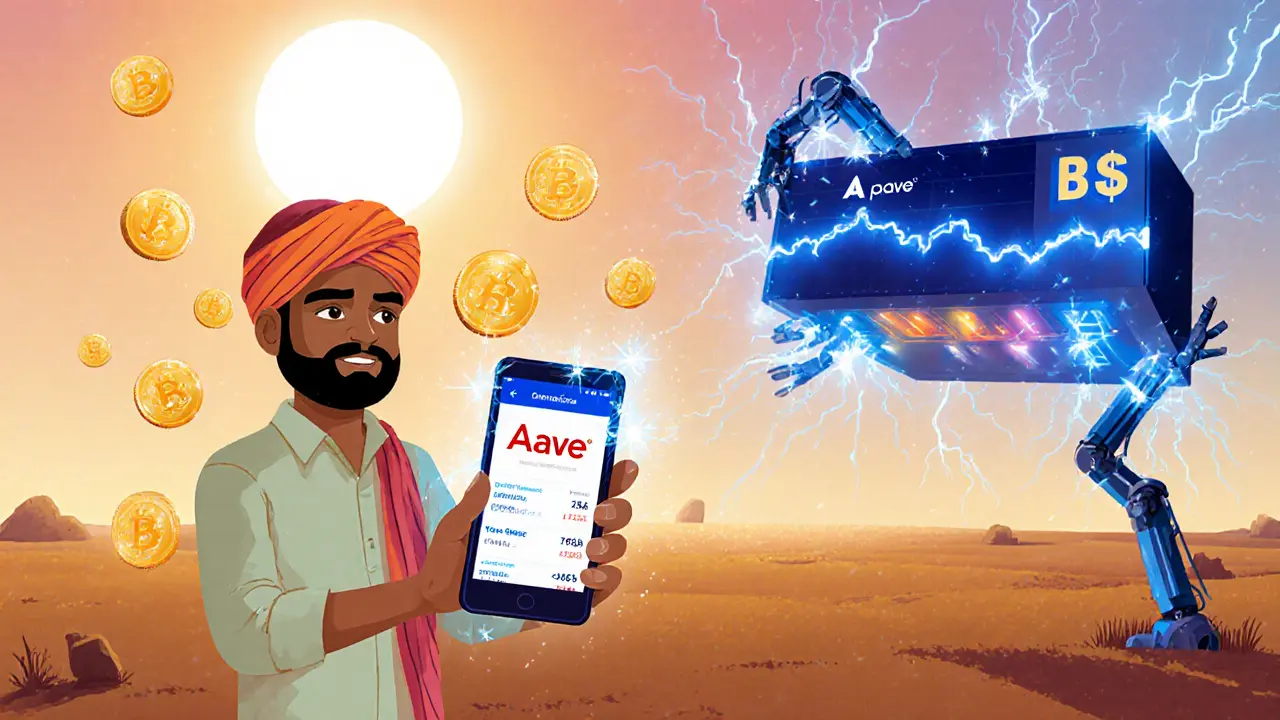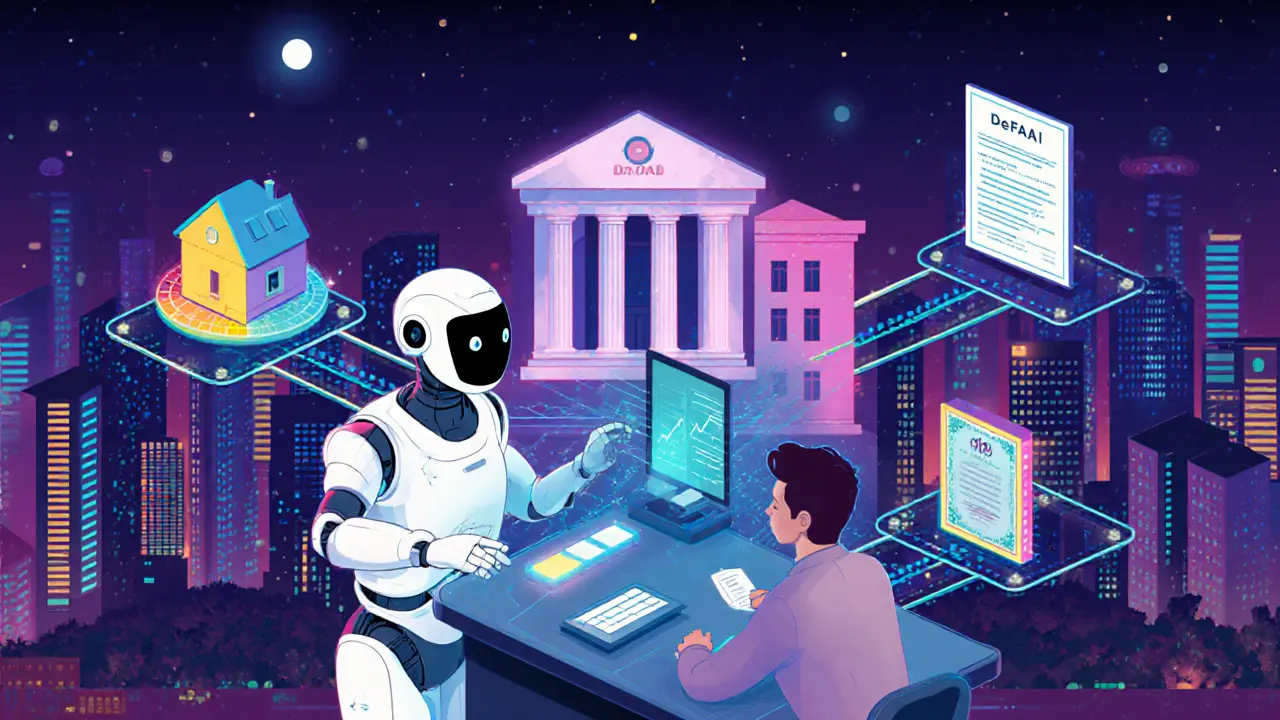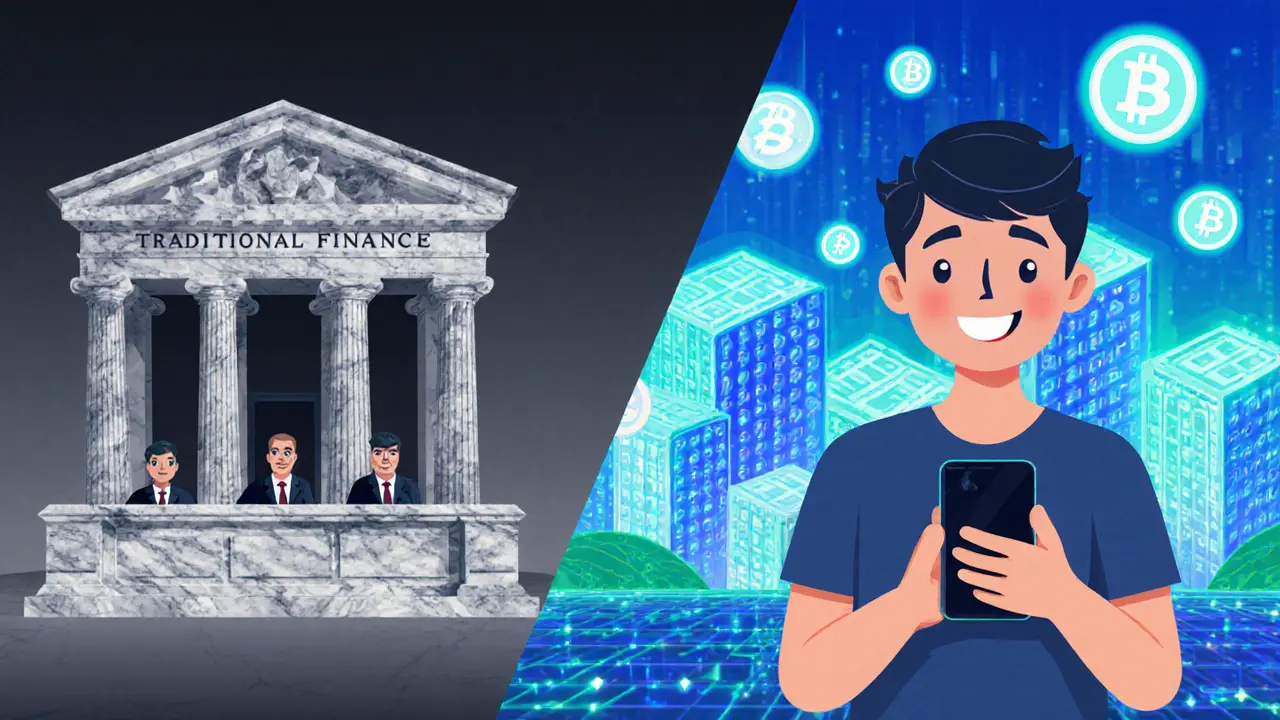DeFi vs Traditional Finance Comparison Tool
Built on public blockchains like Ethereum, using smart contracts to automate financial services without intermediaries.
The established banking and securities system that relies on regulated intermediaries like banks, brokers, and clearinghouses.
| Aspect | DeFi | Traditional Finance |
|---|---|---|
| Custody | Non-custodial wallets like MetaMask allow users to hold their own private keys | Regulated institutions hold customer funds and accounts |
| Access | Permissionless – anyone with internet can participate | Permissioned – requires KYC/AML verification |
| Intermediaries | Smart contracts replace intermediaries | Banks, brokers, clearinghouses |
| Settlement Speed | Seconds to minutes (on-chain confirmation) | T+2 for equities, T+3 for bonds |
| Fees | Gas fees for blockchain transactions | Various fees including interest rates, account maintenance, and transaction fees |
| Global Access | 24/7 access from anywhere with internet | Restricted by business hours and geographical location |
Track how DeFi adoption compares to Traditional Finance:
Analysis: While DeFi currently represents a smaller portion of total financial activity, its rapid growth suggests increasing integration with traditional systems.
Imagine being able to borrow, trade, or earn interest without stepping foot in a bank, without filling out endless forms, and without waiting days for a transaction to settle. That’s the promise of DeFi is a decentralized finance ecosystem that uses blockchain and smart contracts to deliver financial services without traditional intermediaries. In the past few years this ecosystem has grown from a hobbyist playground into a multi‑billion‑dollar industry that’s forcing the old‑school world of Traditional Finance the established banking and securities system that relies on regulated intermediaries like banks, brokers, and clearinghouses to rethink how money moves.
Quick Takeaways
- DeFi handles $1.2trillion in annual transaction volume, far outpacing many niche markets in TradFi.
- Settlement is near‑instant on blockchain versus the T+2 or T+3 cycles of most equities and bonds.
- Anyone with an internet connection and a non‑custodial wallet can access DeFi services 24/7.
- Security, scalability, and regulatory uncertainty remain the three biggest hurdles.
- By 2028, analysts expect roughly 20% of traditional financial products to embed DeFi components.
What DeFi Actually Is
DeFi builds on public blockchains - most notably Ethereum a programmable blockchain that introduced smart contracts and hosts the majority of DeFi protocols. A smart contract self‑executing code that runs on a blockchain and enforces agreed‑upon rules without a middleman replaces the paperwork, approvals, and settlement agents you’d find in a bank. When you deposit crypto into a lending protocol, the contract automatically tracks collateral, calculates interest, and triggers liquidation if the collateral value drops too far.

How DeFi Differs from Traditional Finance
| Aspect | DeFi | Traditional Finance |
|---|---|---|
| Custody | MetaMask a non‑custodial browser wallet that lets users hold private keys themselves | Bank accounts held by regulated institutions |
| Access | Permissionless - anyone can join | Permissioned - KYC/AML checks required |
| Intermediaries | None - smart contracts automate everything | Banks, brokers, clearinghouses |
| Settlement Speed | Seconds to minutes (on‑chain confirmation) | Typically T+2 for equities, T+3 for bonds |
| Fees | Gas fees (often <$0.10 on Layer2) | Commission, custody, and transaction fees (often several percent) |
| Operating Hours | 24/7, global | Business hours, weekdays only |
Disruptive Features That Matter
Permissionless access opens doors for the 1.7billion adults the World Bank says are unbanked. A farmer in Bihar can now lend crypto on Aave a leading DeFi lending protocol that lets users earn interest on deposited assets with a few taps on his phone. No paperwork, no credit score.
Instant settlement removes the lag that costs traders money. In April2025, OSL measured an average DeFi trade confirming in < 15seconds versus the 2‑day waiting period for a typical stock trade.
Lower fees mean more of your capital stays invested. Layer‑2 solutions like Polygon a scaling solution for Ethereum that reduces gas fees dramatically have driven average transaction costs down from $50‑$100 during congestion to under $0.10.
Technical Stack Behind the Magic
DeFi protocols run on public blockchains, with Ethereum still handling about 1.1million daily transactions as of Q12025. To overcome Ethereum’s 15‑30TPS limit, developers deploy Layer2 rollups (Polygon, Optimism) and alternative chains (Solana, BNB Chain). These solutions push throughput to 2000‑4000TPS while keeping security tied to the base layer.
To interact, you need a non‑custodial wallet. Ledger a hardware wallet that stores private keys offline for maximum security offers cold‑storage, while MetaMask a browser extension that manages private keys and connects to dApps handles day‑to‑day transactions.
Decentralized exchanges (DEXs) like Uniswap an automated market maker that lets users swap tokens without a centralized order book or PancakeSwap a Binance‑Smart‑Chain DEX popular for low‑fee swaps provide liquidity pools that anyone can join.

Risks, Challenges, and What to Watch
Security breaches still happen. The Poly Network hack in 2021 drained $600million before the perpetrators returned most funds. Since then, audit firms have cut critical vulnerabilities by 37% year‑over‑year, but the risk cannot be ignored.
Scalability is a moving target. While Layer2 solutions improve throughput, they add complexity and sometimes higher exit fees when moving back to Ethereum mainnet.
Regulatory uncertainty looms large. In the U.S., 32% of DeFi protocols block American users to avoid SEC scrutiny, whereas Singapore and Switzerland provide clearer sandboxes. Tax treatment remains messy; India’s 30% flat crypto tax plus 1% TDS discourages many users.
Finally, the user experience can be steep. Studies show 15‑20hours of learning just to perform basic DeFi actions, and mis‑configured transactions account for a third of user errors.
Future Outlook: Convergence and the Rise of DeFAI
Analysts see three convergence pathways:
- Interoperability protocols that let banks talk to blockchains without rebuilding legacy systems.
- Asset tokenization - turning real‑estate, stocks, or commodities into on‑chain tokens, boosting liquidity by up to 60% in pilot programs.
- Decentralized identity solutions that combine KYC compliance with user privacy.
Crypto.com’s May2025 report coined the term DeFAI the blend of decentralized finance and artificial intelligence that automates complex DeFi interactions. AI agents can suggest optimal yields, rebalance portfolios, and even handle gas‑fee management, flattening the learning curve dramatically.
Even traditional banks are testing the waters. JPMorgan’s Onyx blockchain processed $1billion daily in wholesale payments as of April2025, signaling that large institutions view blockchain as a tool, not a threat.
Yet full disruption is unlikely before 2030. TradFi’s regulatory safety nets, consumer trust, and entrenched infrastructure mean DeFi will probably coexist, offering parallel services that cater to different risk appetites.
Frequently Asked Questions
Is DeFi safe for beginners?
Safety hinges on three factors: using audited contracts, storing keys securely (hardware wallets are best), and starting with small amounts. Even then, the volatile nature of crypto means you should treat DeFi as high‑risk investment.
How do I get started with a DeFi wallet?
Download a browser extension like MetaMask, create a new wallet, write down the seed phrase on paper, and fund it via a centralized exchange. The whole process takes about five minutes.
What’s the difference between a DEX and a centralized exchange?
A DEX swaps tokens directly between users through smart contracts, meaning you never hand over custody. A centralized exchange holds your assets and matches orders on its own books, offering faster onboarding but requiring trust in the platform.
Can I earn interest on my crypto without a bank?
Yes. Protocols like Aave or Compound let you deposit assets and earn algorithm‑determined interest rates that can be higher than traditional savings accounts, though rates can change quickly.
Will regulators shut down DeFi?
Regulators can target on‑ramps (exchanges) and fiat gateways, but the open‑source code lives on public blockchains. The most likely outcome is a patchwork of compliance solutions rather than a complete ban.


DeFi's composability is basically the Lego‑like stacking of protocols-each smart contract can call another, creating liquidity pipelines that traditional banks can’t replicate.
It’s a permissionless sandbox where gas fees are the only friction point.
The non‑custodial aspect also forces users to manage private keys, which is both empowerment and risk.
The hype around DeFi masks a cascade of unvetted code; most of these platforms will crumble under a real market stress test.
The emergence of decentralized finance represents a profound restructuring of the mechanisms by which capital is allocated.
By abstracting intermediation into autonomous code, DeFi reduces reliance upon institutional gatekeepers.
This shift engenders a more inclusive financial ecosystem wherein participants are bounded only by connectivity and computational resources.
Moreover, the transparency inherent to public blockchains permits perpetual auditability of transactional flows.
Such visibility stands in stark contrast to the opaqueness that characterizes many proprietary legacy systems.
Settlement latency, traditionally measured in days, contracts to mere seconds when executed on-chain.
The resultant acceleration of capital turnover augments liquidity efficiency across a spectrum of assets.
Nevertheless, the absence of a centralized dispute resolution entity introduces novel risk vectors.
Smart‑contract vulnerabilities, estimated to have incurred billions in losses, underscore the imperative for rigorous formal verification.
Additionally, the prevailing regulatory ambiguity poses compliance challenges for participants operating across jurisdictions.
From a macroeconomic perspective, the diffusion of DeFi could attenuate the monetary policy transmission mechanisms historically mediated by banks.
Conversely, the composability of protocols fosters systemic interdependence, whereby a failure in one layer may cascade throughout the stack.
Stakeholders therefore must balance the virtues of innovation with prudent risk management strategies.
In practice, hybrid models that integrate on‑chain primitives with off‑chain compliance frameworks appear most sustainable.
Ultimately, the trajectory of decentralized finance will be shaped by the collective resolve of developers, users, and regulators to harmonize openness with security.
Listen, the whole DeFi circus is just a glorified Ponzi scheme that leeches on clueless investors-if you’re not a tech‑geek you’ll get screwed, plain and simple. The gas fees are a nightmare, and the rug pulls? Everyday occurrance. Stop believing the hype and go back to real banks.
It’s encouraging to see how DeFi platforms are experimenting with novel yield‑generation mechanisms, such as liquidity mining and algorithmic stablecoins, which broaden the toolbox available to everyday savers.
These innovations, while still nascent, demonstrate a willingness within the community to iterate rapidly and share knowledge openly, fostering a collaborative environment.
Moreover, the permissionless nature of these protocols lowers entry barriers, allowing participants from diverse geographic and economic backgrounds to contribute capital and ideas.
As we collectively refine security audits and governance models, the ecosystem becomes more resilient, and that resilience benefits everyone involved.
In this spirit of cooperation, I’d like to highlight the importance of cross‑protocol audits, which can surface hidden vulnerabilities before they are exploited.
Yo, if u think banks are safe cuz they got regs, think again-DeFi is where the real money's at.
The tapestry of DeFi is woven with threads of ingenuity, each protocol adding a splash of brilliance that dazzles the financial canvas.
From flash loans that flash like meteors to decentralized exchanges humming like bustling bazaars, the ecosystem pulses with vibrant energy.
DeFi lets anyone with a phone join the market.
You don’t need a bank account.
Just a wallet and some crypto, and you’re good to go.
DeFi, with its borderless architecture, eliminates many of the traditional barriers-KYC, paperwork, and limited trading hours-offering users unparalleled flexibility, speed, and cost‑efficiency.
Brian, you nailed the collaborative spirit-cross‑protocol audits truly are the glue that can hold this fast‑moving ecosystem together.
Don’t you see? The big banks are secretly funding DeFi projects to later gate‑keep the new money flow.
Rug pulls are real, but not every project is a scam.
While many praise DeFi’s transparency, one must consider the hidden layers of complexity-code obfuscation, off‑chain oracles, and the ever‑present risk of smart‑contract bugs-that can obscure true risk.
Oh sure, because every DeFi protocol has a flawless risk management team-said no one ever.
i think the DeFi space is super exciting but also kinda scary, lol.
Heather, could you elaborate on how exactly DeFi reduces transaction costs compared to traditional settlement systems?